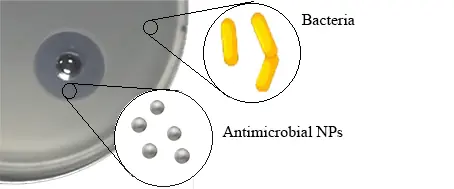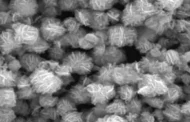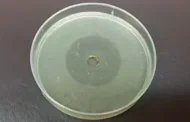NanoMicrobiol NanoBiotechnol, 2022 (1), 202215
DOI: 10.52547/nanomicrob.2022.1.5
Short Review
Antimicrobial nanostructures: most potent structures, applications, and mechanism of action
Alireza Ebrahiminezhad 1*
1 Biotechnology Research Center, Shiraz University of Medical Sciences, Shiraz, Iran
* Correspondence: a_ebrahimi@sums.ac.ir
Abstract
Antimicrobial nanostructures are one of the most studied and well-known field in the nanomicrobiology. Application of metallic compound against microbial infection is belong to ancient time. But application of these compound was limited by discovery and introduction of antibiotics. Emerging of multidrug resistance microbial strains which are resistance to the almost all antibiotics alert us to find new antimicrobial compounds. Antimicrobial nanostructures are among a few promising solutions. In this short review we have a look over the most potent antimicrobial nanostructures, their application in commercial products, and mechanism of antimicrobial effects.
Keywords: Antibacterial; Antifungal; Metal nanoparticles; Titanium nanoparticles; Silver nanoparticles; Cupper Nanoparticles; Zinc nanoparticles
1 Introduction
Nanotechnology and nanomaterial sciences have raised as a novel technology with wide applications and immense impacts on various sciences and technology. Medicine, pharmacy, biotechnology, engineering, aviation, agriculture, chemical products, oil and petroleum industries, environmental sciences, shipping industries, hygiene industries, waste treatment, and biological sciences are among the sciences and technologies which were highly benefited by nanotechnology and nanoscience. Microbiology is not outstanding from these developments that were made in the light of nanotechnology. Nowadays application of nanotechnology and nanoscience in the microbiology developed in various aspects and emerged as a novel field in microbiology which is known as nanomicrobiology.
Nanomicrobiology can be categorized in to some major activities, such as biosynthesis of nanostructures by using microorganisms, antimicrobial nanostructures, immobilization of microorganisms by nanostructures, gene delivery to microbial cells via nanostructures, microbial nanomotors, and so many others. There are huge experimental studies about each of these fields of nanomicrobiology. Studies in some of these fields are so mature that commercial products were developed based on the findings. Antimicrobial nanostructures are one of these most studied and developed fields. Nowadays, some metal nanoparticles such as silver, zinc, zinc oxide, copper, copper oxide, and titanium nanoparticles were well known as their potent antimicrobial properties (1, 2). It is obvious that antimicrobial metallic nanoparticles are not restricted to the mentioned particles and there are other metal nanoparticles that were reported with antimicrobial properties (3). Beside metallic nanoparticles, nonmetallic antimicrobial nanoparticles were also developed such as chitosan nanoparticles, lipid nanoparticles, herbal nanoparticles, and others (4, 5).
2 Applications
By developments in the synthesis and fabrication of nanomaterials, sustainable process was developed and commercial production of antimicrobial nanomaterials were become possible. So, numerous commercial products were developed with antimicrobial properties by employing silver, zinc, or zinc oxide nanoparticles. Antimicrobial wound dressing and antimicrobial gels were among the first antimicrobial products with nano formulations. These antiseptic products were formulated based on the antimicrobial effects of silver nano particles. In the case of antimicrobial hydrogels or ointments, the silver ingredient is usually employed in two weigh/weight percent. Sanitation industries were the other companies that employed antimicrobial properties of nanomaterials in their products. Textile products were also benefited with the antimicrobial properties of nanomaterials. Nano-socks are one of the most famous, but other products were also available. Antimicrobial carpets which were produced by using nano silver or nano zinc functionalized threads can be indicated as the other product that benefited with application of nanomaterials in the textiles industries. Final price is the critical point in the formulation or fabrication of commercial products. Silver is an expensive metal that has an immense impact on the final price. Meanwhile zinc oxide is a cheap and more economic material to be employed in commercial products. Hence in commercial products that have large volumes or consumed large amount of material to be produced, zinc oxide nanoparticles can be considered as a more rational choice. For more about application of antimicrobial nanomaterials in the commercial products which made in Iran you can check out a specific web page which was developed to introduce Iranian nano products with the URL address as https://nanoproduct.ir/.
Antimicrobial nanomaterials became more interesting when it was found that these nanomaterials have synergistic effects with antibiotics. It means that simultaneous application of antimicrobial nanomaterials with antibiotics can increase the efficacy of the antibiotics (6). It means that simultaneous application of antibiotics with the antimicrobial nanomaterials can reduce the minimal inhibitory concentration (MIC) of antibiotics. Also, antimicrobial nanomaterials are able to break the resistance of multidrug resistance strains and make these strains susceptible to common antibiotics (7-10). In this regard, numerous studies were developed to employ antimicrobial nanostructures for delivery of antibiotics against infectious diseases (11). It is interesting that antimicrobial nanomaterials have also synergistic effects with other nanomaterials (12).
Some recent investigations indicated that in some cases antimicrobial nanoparticles have antagonistic effects with antibiotics. It was shown that zin oxide nanoparticles reduce the effectiveness of most antibiotics against Salmonella. Also, silver nanoparticles decrease the effectiveness of oxacillin and neomycin against Staphylococcus aureus (13).
3 Mechanism of action
Mechanism of antimicrobial activity of nanomaterials was remained as a major question for years. Mechanism of antimicrobial activity of each nanomaterial should be investigated separately and it is not possible to determine a particular mechanism for all antimicrobial nanomaterials. In the case of metallic nanoparticles, release of metal ions is the major antimicrobial mechanism. It is obvious that exposure to the oxygen in an aqueous media resulted to progressive oxidation of nanoparticles surface. Metal oxide layer release metal ions and metal ions can perform antimicrobial activities. Metal ions can oxidize biomolecules such as membrane lipids, carbohydrates in the cell envelope, proteins, and nucleic acids in the microbial cells. Also, metal ions can catalyze production of reactive oxygen species (ROS) and ROS can act as toxic compound against microbial cells. This two mechanism was found to be the only mechanisms by which silver nanoparticles can kill microbial cells (14). But some other metallic nanoparticles like titanium oxide nanoparticles were reported to kill microbial cells via direct physical interactions with the surface of the cells. Extremely small size of these nanoparticles make them able to penetrate to microbial cell envelope and disrupt cell integrity (15).
Conclusions
Antimicrobial nanostructures were among one of the most studied and employed nanomaterials. Due to their valuable effect against microbial infections these structures were employed in various medical and commercial settings. Silver nanoparticles were known as the most potent and first choice against microbial cells. But silver is an expensive metal and commercial employment of silver nanoparticles is not economically possible in all products. So, zinc or zinc oxide nanoparticles were introduced as less costly substitution for silver nanoparticles. Cupper is the other metallic nanoparticle that is employed against fungal infections. These metallic nanoparticles can be considered as the first choices for the fabrication of antimicrobial products.
Acknowledgments: This work was supported by Shiraz University of Medical Sciences, Shiraz, Iran.
Conflicts of Interest: The authors declare no conflict of interest.
References
- Sharma D, Shandilya P, Saini N, Singh P, Thakur V, Saini R, et al. Insights into the synthesis and mechanism of green synthesized antimicrobial nanoparticles, answer to the multidrug resistance. Mater Today Chem. 2021;19:100391. DOI: 10.1016/j.mtchem.2020.
- Wang L, Hu C, Shao L. The antimicrobial activity of nanoparticles: present situation and prospects for the future. Int J Nanomedicine. 2017;12:1227–49.
- Azhir E, Etefagh R, Mashreghi M, Pordeli P. Preparation, characterization and antibacterial activity of manganese oxide nanoparticles. Phys Chem Res. 2015;3(3):197-204.
- Thorn CR, Thomas N, Boyd BJ, Prestidge CA. Nano-fats for bugs: The benefits of lipid nanoparticles for antimicrobial therapy. Drug Deliv Transl Res. 2021;11:1-27.
- El-Aassar M, Ibrahim OM, Fouda MM, Fakhry H, Ajarem J, Maodaa SN, et al. Wound dressing of chitosan-based-crosslinked gelatin/polyvinyl pyrrolidone embedded silver nanoparticles, for targeting multidrug resistance microbes. Carbohydr Polym. 2021;255:117484. DOI: 10.1016/j.carbpol.2020.
- Geoprincy G, Saravanan P, Gandhi NN, Renganathan S. A novel approach for studying the combined antimicrobial effects of silver nanoparticles and antibiotics through agar over layer method and disk diffusion method. Dig J Nanomater Bios. 2011;6(4):1557-65.
- Devi LS, Joshi S. Antimicrobial and synergistic effects of silver nanoparticles synthesized using soil fungi of high altitudes of Eastern Himalaya. Mycobiology. 2012;40(1):27-34.
- Fayaz AM, Balaji K, Girilal M, Yadav R, Kalaichelvan PT, Venketesan R. Biogenic synthesis of silver nanoparticles and their synergistic effect with antibiotics: a study against gram-positive and gram-negative bacteria. Nanomed Nanotechnol Biol Med. 2010;6(1):103-9.
- Ruden S, Hilpert K, Berditsch M, Wadhwani P, Ulrich AS. Synergistic interaction between silver nanoparticles and membrane-permeabilizing antimicrobial peptides. Antimicrob Agents Chemother. 2009;53(8):3538-40.
- Shahverdi AR, Fakhimi A, Shahverdi HR, Minaian S. Synthesis and effect of silver nanoparticles on the antibacterial activity of different antibiotics against Staphylococcus aureus and Escherichia coli. Nanomed Nanotechnol Biol Med. 2007;3(2):168-71.
- Pirouzifard MK, Pirsa S. Evaluation of release and antibacterial properties of alginate hydrogel containing beta-cyclodextrin nanoparticles loaded with Thymus daenensis essential oil. Food Sci Technol. 2021;18(115):49-67.
- Taghizadeh S-M, Berenjian A, Taghizadeh S, Ghasemi Y, Taherpour A, Sarmah AK, et al. One-put green synthesis of multifunctional silver iron core-shell nanostructure with antimicrobial and catalytic properties. Indus Crops Prod. 2019;130:230-6.
- Abo-Shama UH, El-Gendy H, Mousa WS, Hamouda RA, Yousuf WE, Hetta HF, et al. Synergistic and antagonistic effects of metal nanoparticles in combination with antibiotics against some reference strains of pathogenic microorganisms. Infect Drug Resist. 2020;13:351-62.
- Xiu Z-m, Zhang Q-b, Puppala HL, Colvin VL, Alvarez PJ. Negligible particle-specific antibacterial activity of silver nanoparticles. Nano Lett. 2012;12(8):4271-5.
- Zhang C, Maruggi G, Shan H, Li J. Advances in mRNA vaccines for infectious diseases. Front Immunol. 2019;10:594. DOI: 10.3389/fimmu.2019.00594






